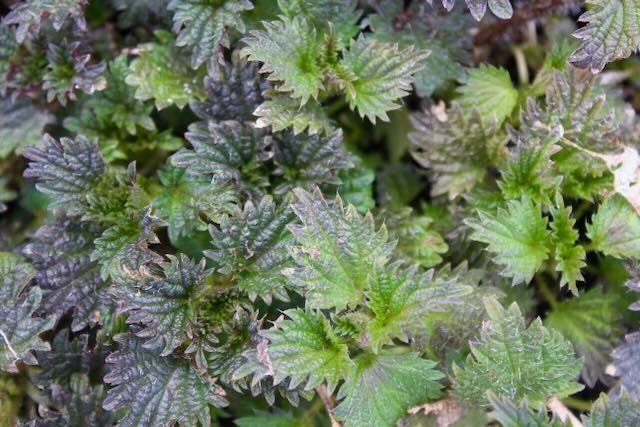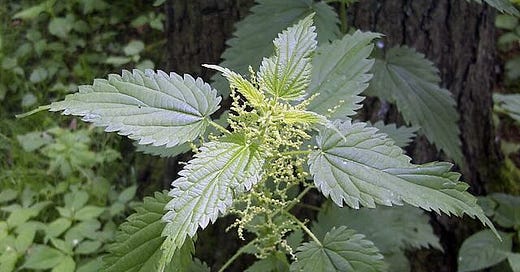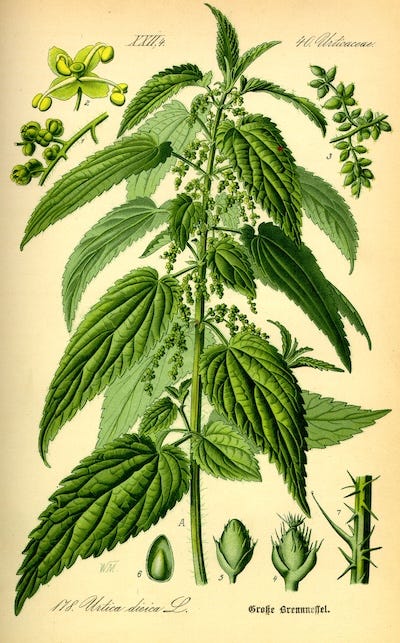Wild Stories: Stinging Nettle
A weedy wonder of a plant with a long history of use as food, fiber & medicine
Wild Stories is a monthly essay in which I write about an animal, a plant, a landscape, or a natural phenomenon. I have studied nature for decades through observation, physical experience, and books. We share the planet with an abundance of species who inspire awe, wonder, joy, respect, and occasionally fear. For most of human existence, we have maintained a kinship and reverence for our co-species.
With Wild Stories, I want to encourage a curiosity and desire to learn more about the lives of our flora and fauna and the remarkable and complicated landscapes we live in. The first three essays featured animals: corvids, polar bears, and skunks. With plant season upon us, I will explore plants throughout the season.
People seldom forget the first time they encounter stinging nettle: it leaves a painful memory. For some, that first experience is embedded so deeply that it triggers an immediate reaction. Once, while giving a plant walk, I pointed out stinging nettle, and several people visibly moved away, as if the plant would attack them!
But stay with me: I’d like you to meet the weedy stinging nettle, I have come to know and value. It’s an unassuming plant with a rich history of human use as a food, traditional medicine, and textile fiber.
Biology
Stinging nettle (Urtica dioica) is a fast-growing herbaceous perennial native to the U.S. and Eurasia. It has settled extensively in temperate regions throughout the world, favoring places with an abundance of precipitation. It thrives in rich, damp soils, and you will often find it growing along pond and riparian edges and roadside ditches. Nettle has adapted to various ecological niches and light conditions, including forest edges, mountain meadows, shady lowlands, and even sagebrush deserts. Because it prefers rich soil, nettle patches are considered an indicator of good soil. In northern Europe, nettle plants often indicate historical human activity, with large patches seeking the buried nutrition of abandoned homesteads, farm fields, hedgerows, gardens, barnyards, and buildings.
It’s rather nondescript in appearance, and you may have walked by it without stopping to notice. Ranging in height from 2-7 feet on stiff, fibrous, square stalks with opposite and coarsely toothed leaves, nettle produces small, inconspicuous flowers that bloom from May through September. The flowers become tiny green fruits that contain even tinier seeds. Its well-earned reputation as an aggressive plant is due to its dual methods of reproduction: quickly growing underground rhizomes and stolons, and wind-blown tiny seeds that create colonies of nettle.
Why It Stings
What it lacks in distinctive appearance, it makes up for in its character. The plant is well-protected by tiny syringe-like hairs called trichomes that cover the stem and leaves. They react to immediate contact - even an accidental brief encounter creates a stinging sensation, reddens the skin, and makes you cry if you are three years old.
The trichomes act like a hypodermic needle, injecting histamine, acetylcholine, serotonin, and formic acid into your skin. The inflammatory reaction (called contact urticaria) can last for a few hours or longer, depending on the amount of contact and an individual’s sensitivity level.

In the Kitchen
Before refrigeration and a global food supply that distributes fresh fruits and vegetables year-round, early spring nettle and other wild greens were welcomed as a tonic of vitamins and minerals after a bland winter diet of dried grains, fruits, and meat.
Stinging nettle is a nutrient powerhouse. One 2013 study concluded: “Results show that processed nettle can supply 90%-100% of vitamin A (including vitamin A as β-carotene) and is a good source of dietary calcium, iron, and protein. We recommend fresh or processed nettle as a high-protein, low-calorie source of essential nutrients, minerals, and vitamins, particularly in vegetarian, diabetic, or other specialized diets.”
I use freshly harvested stinging nettle like cooked spinach: in soups, casseroles, lasagna, smoothies, spanakopita, stir-fries, and pesto. Nettle is not as abundant as a wild weed in my arid climate (usually found in roadside ditches filled with road pollutants), so I purchase organic dried nettle (from herbal farms or companies). I use it for infusions, throw a handful into soups, and have made a delicious nettle cake (recipes online) and topped it with stewed rhubarb and Greek yogurt. Dried nettle is easy to add to breads, biscuits, pizza crust, and cookies, and can be used as a seasoning in just about anything.
I make nettle vinegar, which I use for a vinaigrette dressing: In a quart jar, mix 2 cups of fresh chopped nettle leaves (wearing gloves to harvest and handle!) or 1 cup dried nettle with 2 cups apple cider vinegar. Cover with a plastic lid (metal lids will corrode, but you can place a piece of parchment paper under a metal lid) and shake each day for four weeks. Decant and enjoy the nutritional benefits of nettle vinegar.
But what about the sting? Wear gloves and long sleeves to avoid the sting when harvesting and processing fresh leaves. Cooking, blanching, and drying nettle deactivate the stinging chemicals. And for some reason, if you puree fresh leaves for pesto, the stinging disappears.
In the Apothecary
I first discovered nettle medicinally when I developed a severe hay allergy while living on land where hay was grown. When I say severe, I mean congestion, sneezing, dripping, itching, swelling, and just plain misery. I was afraid to go outside, and as a gardener, that was not an option.
My herbal studies revealed that stinging nettle had potential as a natural solution for seasonal allergies. Once I committed to drinking weekly nettle infusions, I noticed a significant reduction in my allergic reactions the following spring and summer. During late winter, I increase my intake of nettle infusions and use nettle seed tincture for my occasional and now-mild allergic symptoms. Nettle has a strong drying action, and some people have difficulty with its effects, including headaches. (Note: Medicinal uses of herbs should always be researched for possible herb-drug interactions and safety considerations.)
Stinging nettle is an acquired taste—I gagged the first time I tried it! Despite the grassy taste, I now drink it year-round because it is also an excellent source of calcium and magnesium that supports my bone health. I add a handful of oat straw and a couple of pinches of peppermint or spearmint to offset the taste and drying effect, pour just-boiled water over, and steep for 4-8 hours. I prefer it chilled.
Or maybe as a beer…
In Sacred and Herbal Healing Beers, Stephen Harrod Buhner describes the history of ancient fermentation, of which beer was one of the earliest products. Nettle beer was considered a tonic because of its medicinal properties, and historic texts record it as helpful for joint pain.
Medicinal Benefits
Nettle offers the following plant properties: nutritive, alterative, diuretic, astringent, hemostatic, adaptogen, and trophorestorative (i.e., a tonic) for the kidneys and adrenals. Historically, nettle was used in traditional medicine for gout, diarrhea, dysentery, scurvy, kidney stones, rheumatism, and eczema. Modern research on nettle’s nutritive and medicinal qualities supports many traditional uses.
Minimizes seasonal allergic symptoms (leaf)
Reduces inflammation associated with type 2 diabetes (leaf)
Improves energy levels (leaf)
Diuretic action relieves fluid congestion (leaf)
Supports urinary health (leaf)
May reduce the risk of kidney stones (leaf)
Supports kidney health (seed tincture and leaf)
Helps enlarged prostate symptoms (root)
Urtication Therapy
Plant medicine can come in various forms, and urtication is one example of an unusual method. Years ago, I made a presentation on medicinal plants in the garden and mentioned stinging nettle for the many reasons I have already discussed here. Afterward, an older woman whose gnarled hands revealed the long-term effects of arthritis, approached me to share her use of nettle. Diagnosed as a child, her country doctor told her to visit a nettle patch once a week and rub her hands with nettle leaves. Half-jokingly, I replied, “That would definitely cause me to be distracted from my arthritic pain!”
But its effect on the body is, in fact, therapeutic: external contact with fresh nettle stimulates the skin, acting as a counter-irritant that motivates the nervous system to focus on the immediate stinging pain, and blocking the chronic pain of joint diseases. Nettle sting increases the circulation to tissues, which helps relieve stiffness and swelling. Though there are no clinical trials supporting fresh nettle and its stinging chemicals as a treatment for joint pain, their historical use is consistent among both European and Indigenous people. This remedy is not one-size-fits-all: some people develop a more severe reaction to nettle stings, and that discomfort is an example of the idiom, “the cure is worse than the disease.”

In the Fiber Shed
Long forgotten in modern fashion, nettle, flax, and hemp were the primary fibers used to make household linens, clothing, paper, and sailcloth. Evidence of nettle use has been found in 30,000-year-old archeological sites, and cloth woven of nettle thread has been found in 5,000-year-old burial sites.
Nettle fibers can be rolled to make cordage and rope, which are used to make nets. It’s spun to make thread and yarn for textiles, and its durability is one of its strengths. The leaves make green dye, and nettle’s roots produce a yellow dye. During WWI and WWII, when cotton shortages occurred, nettle was cultivated for fiber, specifically for German military uniforms.
Like hemp and flax, nettle stems produce a bast fiber from the cellulosic “inner bark” or the phloem of the plant’s stalk. The processing of the bast fiber is multi-stepped:
Stalks are retted (moistened to soften the stalk and fiber).
The outer bark is stripped, and the raw fibers are removed.
Raw fibers are then soaked to de-gum the chemical binding substances.
Fibers are washed, dried, and carded into a spinnable fiber.
In this ten-minute video, textile artist Allan Brown demonstrates the process from harvest to thread. His exploration of nettle as fiber was filmed and edited into a touching documentary about creating a nettle dress while mourning the death of his wife, which can be rented for online viewing. You can view the 2-minute trailer here.
History and Folklore
Nettle was an essential plant in early Europe before the Industrial Revolution began, and poems, fairytales, herbals, literature, and even politics highlight its uses and benefits.
“When the nettle is young, the leaves make excellent greens; when it grows old it has filaments and fibers like hemp and flax. Cloth made from the nettle is as good as that made from hemp. Chopped up, the nettle is good for poultry; pounded, it is good for horned cattle. The seed of the nettle mixed with the fodder of animals gives a luster to their skin; the root, mixed with salt, produces a beautiful yellow dye. It makes, however, excellent hay, as it can be cut twice in a season. And what does the nettle need? Very little soil, no care, no culture; except that the seeds fall as fast as they ripen, and it is difficult to gather them; that is all. If we would take a little pains, the nettle would be useful; we neglect it, and it becomes harmful. Then we kill it. How much men are like the nettle! My friends, remember this, that there are no weeds, and no worthless men, there are only bad farmers.”
― Victor Hugo, author, Les Misérables
The craft of making nettle yarn is featured in Hans Christian Andersen’s fairytale The Wild Swans: the sister of eleven (or six, depending on the version) brothers who were changed into swans is told the only way she can rescue them is to harvest, process, spin, knit/weave, and then deliver a shirt for each brother to put on.
“Quantities of the same sort grow round the cave in which you sleep, but only these, and those that grow on the graves of a churchyard, will be of any use to you. These you must gather, even while they burn blisters on your hands. Break them to pieces with your hands and feet, and they will become flax, from which you must spin and weave eleven coats with long sleeves”
Folklorist and author Terri Windling has written several posts on stinging nettle for her website. In this paragraph, she describes metaphors that are analogous to this wild weed and women:
“Nettles, folk tales around the world agree, have long been associated with women's domestic magic: with inner strength and fortitude, with healing and also self-healing, with protection and also self-protection, with the ability to "enrich the soil" wherever we have been planted. Nettle magic is steeped in dualities: both fierce and soft, painful and restorative, common as weeds and priceless as jewels. Potent. Tenacious. Humble and often overlooked. Resilient.”
Thank you for being here. All of my posts are free, but if you’d like to support my work, you can do so by:
Liking and restacking this post so others are encouraged to read it.
Share this post via email or on social media.
Taking out a paid subscription to this Substack.
If you find my content educational and/or entertaining, please consider a paid subscription. I would be eternally grateful, as would my coffee and tea habits.
Do you have a painful experience or a delicious recipe with stinging nettle? Share in the comments.










Wow, I've always known that nettles are versatile and useful but you've shared a lot of info here that i wasn't already aware of. Thanks
Thanks for this in depth exploration, Sue! When I was reviewing medical data for adverse reactions at the injection site all those years ago working in clinical research, I never wondered where 'urticaria' came from. Makes so much sense!